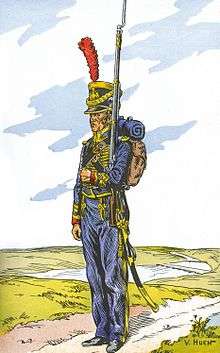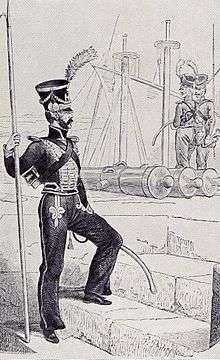Sailors of the Imperial Guard

The Marines of the Imperial Guard (French: marins de la Garde Imperiale) formed a naval unit within the Imperial Guard of Napoleon I. The men of the unit not only operated as naval infantrymen but as gunners (after the training they had received in naval gunnery), sailors and engineers. Napoleon himself stated "They were good sailors, then they were the best soldiers. And they did everything - they were soldiers, gunners, sappers, everything!"[1]
History
When Napoleon was crowned emperor on 2 December 1804, the Marin battalion of the Consular Guard consisted of 820 officers, non-commissioned officers and ratings. Napoleon integrated that battalion into the Imperial Guard in 5 crews totaling 818 officers and men. Its ranks were those of the navy not the army and each crew was commanded by a 'capitaine de frégate' or 'capitaine de vaisseau' and four other officers, with 15 non-commissioned officers and 125 ratings.

The new unit's first task to form part of the force at Boulogne for the Napoleon's planned invasion of the United Kingdom. They not only built boats for the force, but also served in their primary role as an elite unit to bolster naval crews, which often had little training or experience. When the invasion was called off, part of the unit fought in the 1805 Austrian campaign, fighting at Ulm and Austerlitz. In 1806, 102 men from the unit took part in the Prussian campaign, fighting at Jena and especially in the siege of Danzig, where they formed part of Chasseloup-Laubat's force of engineers. They followed the Grande Armée into Poland, where they were rejoined by the crews who had remained in France. Together they then fought at Eylau and Friedland.
After the peace of Tilsit, the unit was sent back to France, but left for the Peninsular War soon afterwards. Under the orders of general Dupont, they took an active part in the battle of Bailen, where they suffered heavy losses. The survivors were taken prisoner and sent to Cadiz on barges, where some of them remained until 1814. The unit had to be re-formed from scratch in March 1809, but was now only a single crew of 150 officers and men, which fought at Wagram under the command of capitaine de vaisseau Baste, mainly as gunners.
In September 1810 8 more crews were added, raising the unit's strength to 1,136 officers, NCOs and ratings. It suffered badly in the Invasion of Russia, fighting in several battles and decimated by cold, hunger and disease - only 85 of its officers and men were still alive when the army crossed back into Germany. Reorganised and brought up to strength with new recruits, the unit fought at Leipzig as part of the infantry component of the Young Guard.
In 1814 the unit took part in the French campaign, notably the defence of Paris. A small detachment of 21 marines from the unit accompanied Napoleon into exile on Elba.[2] During the Hundred Days one crew of 150 was re-formed,[3] which fought at Ligny and Waterloo - at the latter they covered the retreat of the 1st Grenadier Regiment and 1st Foot Chasseurs of the Old Guard. They were finally disbanded on 15 August 1815.
Uniform
The uniform consisted of a blue tunic and Hungarian-style trousers. The tunic had red cuffs, decorations in the dolman style and scale epaulettes. The shako was black with a scarlet plume and an eagle helmet-plate and the shoes, waistbelt and cross-belt were also black. The waistbelt was in the light cavalry style.
Commanders

- 1805 : François Henri Eugène Daugier
- 1809 : Pierre Baste
- 1810 : Antoine Vattier
- 1811 : Honoré Joseph Antoine Ganteaume
- 1813 : Louis Pierre François Ricard Barthélémy de Saizeu
- 1815 : Capitaine de frégate Taillade[4]
References
- ↑ Philip Haythornthwaite, The Imperial Guard, Osprey Publishing, 2004 (ISBN 2-84349-178-9), page 7
- ↑ Henry Houssaye, 1815, Paris, Perrin et cie, 1921, p.148
- ↑ http://www.histoiredumonde.net/Marins-de-la-Garde.html
- ↑ http://www.napoleon-series.org/military/organization/frenchguard/c_guardmarins.html